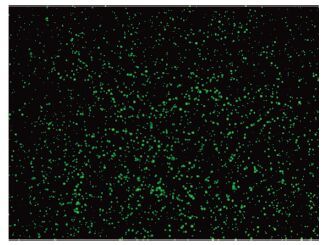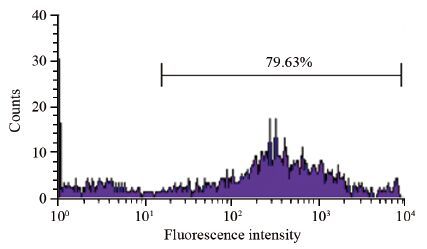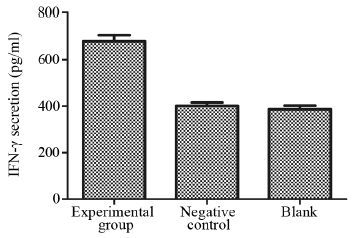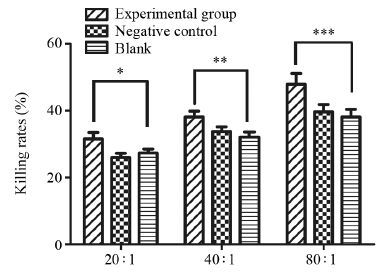Immune Killing Effect of Silencing TIPE2 Expression on T Lymphocytes Against Lung Adenocarcinoma Cells LA795
-
摘要:目的
利用特异性小干扰RNA(small interfering RNA, siRNA)技术沉默T细胞TIPE2基因表达, 体外观察转染T细胞对肺腺癌细胞LA795的免疫杀伤作用。
方法磁珠分选小鼠脾脏T细胞, 筛选并验证能有效沉默T淋巴细胞TIPE2基因的siRNA序列, 转染48 h后, 利用酶联免疫吸附法(ELISA)比较各分组细胞上清液中IFN-γ分泌水平;转染72 h后, 观察对比单纯T细胞(空白组)、阴性对照T细胞(阴性对照组)及转染T细胞(实验组)与小鼠肺腺癌细胞LA795共培养时肿瘤杀伤率。
结果我们筛选出一条能有效抑制TIPE2基因表达的siRNA序列, 细胞转染率79.63%, 蛋白表达抑制率达到79%, 转染48 h后, 检测实验组、阴性对照组、空白组细胞因子IFN-γ分泌水平分别为(678.96±26.91)pg/ml、(401.69±13.67)pg/ml、(387.03±15.14)pg/ml(P<0.001);转染72 h后, 与空白组及阴性对照组T细胞相比, 在不同的效靶比水平(20:1、40:1、80:1), 转染T细胞杀瘤活性均更高。当效靶比为80:1时, 实验组肿瘤细胞杀伤率达到(47.91±3.25)%。
结论利用特异性siRNA技术能有效沉默TIPE2基因, 并促进抗肿瘤活性细胞因子IFN-γ分泌, 增强T细胞对小鼠肺腺癌细胞LA795的体外免疫杀伤作用。
-
关键词:
- 肿瘤坏死因子α诱导蛋白2 /
- 基因沉默 /
- T细胞 /
- 肺癌 /
- 免疫治疗
Abstract:ObjectiveTo silence the expression of tumor necrosis factor-α-induced protein-8-like 2 (TIPE2) gene of T-lymphocytes by specific small interfering RNA (siRNA) and investigate the cytotoxicity activity of transfected T lymphocytes against lung adenocarcinoma cells LA795 in vitro.
MethodsSpleen T lymphocytes of mice were separated by magnetic bead, and we screened and validated an effective siRNA to silence TIPE2 gene of T lymphocytes. After 48h transfection, the secretion of IFN-γ was measured by enzyme-linked immuno-sorbent assay (ELISA). At the end, 72h after transfection, we compared the cytotoxicity activity changes against LA795 cells among transfected T lymphocytes(experimental group), negative control and simplex T lymphocytes(blank group) in vitro.
ResultsWe screened a siRNA sequences to effectively inhibit the expression of TIPE2 gene, the transfection rate was 79.63%, and the inhibition rate for TIPE2 protein expression reached 79%. After 48h transfection, the secretion level of IFN-γ in experimental group, negative control and blank group respectively were (678.96±26.91), (401.69±13.67) and (387.03±15.14)pg/ml (P<0.001). After 72h transfection, compared with negative control and blank group, the transfected T lymphocyte showed more efficient killing ability against LA795 cells in different level of effect/target(20:1, 40:1, 80:1). The killing rate of experimental group reached (47.91±3.25)% in effect/target of 80:1.
ConclusionSilencing TIPE2 could significantly promote the secretion level of IFN-γ of mice T lymphocyte, enhance the cytotoxicity activity of T lymphocyte against LA795 lung adenocarcinoma cells in vitro.
-
Key words:
- TIPE2 /
- Gene silencing /
- T lymphocytes /
- Lung cancer /
- Immunotherapy
-
-
表 1 siRNA及阴性对照序列信息
Table 1 Sequence information of siRNA and negative control

-
[1] Felten MK, Knoll L, Schikowsky C, et al. Is it useful to combine sputum cytology and low-dose spiral computed tomography for early detection of lung cancer in formerly asbestos-exposed power industry workers?[J]. J Occup Med Toxicol, 2014, 9:14. [1] Felten MK, Knoll L, Schikowsky C, et al. Is it useful to combine sputum cytology and low-dose spiral computed tomography for early detection of lung cancer in formerly asbestos-exposed power industry workers?[J]. J Occup Med Toxicol, 2014, 9:14. doi: 10.1186/1745-6673-9-14
[2] Iversen TZ. Immune modulations during chemoimmunotherapy & novel vaccine strategies-in metastatic melanoma and non small-cell lung cancer[J]. Dan Med J, 2013, 60(12): B4774. http://www.ncbi.nlm.nih.gov/pubmed/24355457
[2] Iversen TZ. Immune modulations during chemoimmunotherapy & novel vaccine strategies-in metastatic melanoma and non smallcell lung cancer[J]. Dan Med J, 2013, 60(12): B4774. [3] Aerts JG, Hegmans JP. Tumor-specific cytotoxic T cells are crucial for efficacy of immunomodulatory antibodies in patients with lung cancer[J]. Cancer Res, 2013 ,73(8): 2381-8. [3] Aerts JG, Hegmans JP. Tumor-specific cytotoxic T cells are crucial for efficacy of immunomodulatory antibodies in patients with lung cancer[J]. Cancer Res, 2013 ,73(8): 2381-8. doi: 10.1158/0008-5472.CAN-12-3932
[4] Sun H, Gong S, Carmody RJ, et al. TIPE2, a negative regulator of innate and adaptive immunity that maintains immune homeostasis[J]. Cell, 2008, 133(3): 415-26. [4] Sun H, Gong S, Carmody RJ, et al. TIPE2, a negative regulator of innate and adaptive immunity that maintains immune homeostasis[J]. Cell, 2008, 133(3): 415-26. doi: 10.1016/j.cell.2008.03.026
[5] Zhang W, Zhang J, Zhao L, et al. TIPE2 protein negatively regulates HBV-specific CD8+ T lymphocyte functions in humans[J]. Mol Immunol, 2015, 64(1): 204-9. [5] Zhang W, Zhang J, Zhao L, et al. TIPE2 protein negatively regulates HBV-specific CD8+ T lymphocyte functions in humans[J]. Mol Immunol, 2015, 64(1): 204-9. doi: 10.1016/j.molimm.2014.11.019
[6] Xu HS, Wu YW, Xu SF, et al. Antitumor and immunomodulatory activity of polysaccharides from the roots of Actinidia eriantha[J]. J Ethnopharmacol, 2009, 125(2): 310-7. [6] Xu HS, Wu YW, Xu SF, et al. Antitumor and immunomodulatory activity of polysaccharides from the roots of Actinidia eriantha[J]. J Ethnopharmacol, 2009, 125(2): 310-7. doi: 10.1016/j.jep.2009.06.015
[7] Marr LA, Gilham DE, Campbell JD, et al. Immunology in the clinic review series; focus on cancer: double trouble for tumours: bi-functional and redirected T cells as effective cancer immunotherapies[J]. Clin Exp Immunol, 2012, 167(2): 216-25. doi: 10.1111/j.1365-2249.2011.04517.x
[7] Marr LA, Gilham DE, Campbell JD, et al. Immunology in the clinic review series; focus on cancer: double trouble for tumours: bi-functional and redirected T cells as effective cancer immunotherapies[J]. Clin Exp Immunol, 2012, 167(2): 216-25. [8] Neurath MF, Finotto S. The emerging role of T cell cytokines in non-small cell lung cancer[J]. Cytokine Growth Factor Rev, 2012, 23 (6): 315-22. [8] Neurath MF, Finotto S. The emerging role of T cell cytokines in non-small cell lung cancer[J]. Cytokine Growth Factor Rev, 2012, 23(6): 315-22. doi: 10.1016/j.cytogfr.2012.08.009
[9] Horne ZD, Jack R, Gray ZT, et al. Increased levels of tumor-infiltrating lymphocytes are associated with improved recurrence-free survival in stage 1A non-small-cell lung cancer[J]. J Surg Res, 2011, 171(1): 1-5. doi: 10.1016/j.jss.2011.03.068
[9] Horne ZD, Jack R, Gray ZT, et al. Increased levels of tumorinfiltrating lymphocytes are associated with improved recurrencefree survival in stage 1A non-small-cell lung cancer[J]. J Surg Res, 2011, 171(1): 1-5. [10] Luan YY, Yao YM, Zhang L, et al. Expression of tumor necrosis factor-α induced protein 8 like-2 contributes to the immunosuppressive property of CD4(+)CD25(+) regulatory T cells in mice[J]. Mol Immunol, 2011, 49(1-2): 219-26. doi: 10.1016/j.molimm.2011.08.016
[10] Luan YY, Yao YM, Zhang L, et al. Expression of tumor necrosis factor-α induced protein 8 like-2 contributes to the immunosuppressive property of CD4(+)CD25(+) regulatory T cells in mice[J]. Mol Immunol, 2011, 49(1-2): 219-26. [11] Andersen MH, Schrama D, Thor Straten P, et al. Cytotoxic T cells[J]. J Invest Dermatol, 2006, 126(1): 32-41. doi: 10.1038/sj.jid.5700001
[11] Andersen MH, Schrama D, Thor Straten P, et al. Cytotoxic T cells[J]. J Invest Dermatol, 2006, 126(1): 32-41.




 下载:
下载:





